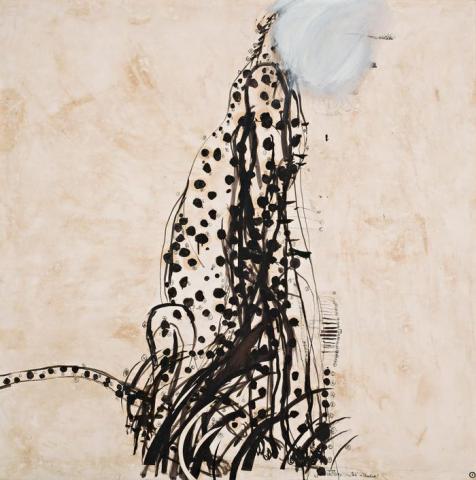CHEETAH OR CHEATAH (ANIMAL OR LIFE), 1965
Brett Whiteley
oil and mixed media on paper on canvas
152.0 x 152.0 cm
signed, dated and inscribed with title lower right: Brett/ Whiteley “Cheetah” or ”cheatah?” / 65
Marlborough New London Gallery, London
Private collection
Christie's, Melbourne, 30 July 1990, lot 98
Sotheby's, Melbourne, 26 April 1992, lot 374
Private collection, Sydney
Brett Whiteley: London Zoo Series, Marlborough New London Gallery, London, 1965, cat. 5 (as'Cheetah or Cheata')
McGrath, S., Brett Whiteley, Bay Books, Sydney, 1979, p. 69 (illus.)
When Cheetah or Cheatah (Animal or Life) was first unveiled at Marlborough Galleries, London in Autumn 1965, the work - together with the thirteen other paintings and six sculptures of chimpanzees, gorillas, apes, monkeys, giraffes and lions comprising the 'London Zoo series' - barely elicited a response from critics. Consuming their attention rather, were the artist's highly provocative and brutal images exploring the sordid crimes of necrophiliac murderer, John Christie, alongside which the London Zoo works had been exhibited. Living in London during the early 1960s, Whiteley had become fascinated by the city's milieu of latent violence, and in particular, the dark saga of Christie who, posing as a doctor, had lured his victims on the pretext of curing their ailments only to subsequently gas them to death, ravish their bodies and hide them within the walls of his house in Rillington Place. Arguably the artist's most ambitious series to date, the Christie pictures were intended to establish Whiteley's reputation in the London art world, and did so: the highly sensational series was an instant triumph and today endures as among his greatest achievements.
For the rare few who did notice this bizarre mélange of bestial and beast, there was a total lack of appreciation for the quite deliberate thematic association. Indeed, Whiteley had conceived of the London Zoo series as a deliberate foil, contradiction and antidote to the Christie paintings - symbolically the animal kingdom represented the forces of good while Christie's world was one of depraved evil.1 There were also tempting conceptual links to which the artist alluded, at times quite pointedly - for example, the title of the present work suggests a predatory animal stalking its victims both literally ('Cheetah' and 'Animal') and figuratively ('Cheatah' and 'Life'). Moreover, if Whiteley's abiding preoccupation with this Baudelairean duality between good and evil underpinned the creation of the London Zoo series, it also arguably informed his decision to embark upon the Christie paintings in the first instance. These works examined with sharp explicitness the evil side of sexual drive within the human condition, and were the complete antithesis of the Bathroom theme created immediately prior, a series which still constitutes one of the most tender expressions in contemporary art of a man's love for a woman.
Stylistically, both the Christie and London Zoo series betray strong affinities with the art of figurative painter Francis Bacon, the unquestioned titan of British art at the time - in the case of the Christie works, it was his sleek, monumental nudes twisted and contorted in vulgar acts, while the Zoo paintings unmistakably recalled the older artist's caged figures. Exploring confinement as a formal device, here Whiteley is not interested in recording details of the animals' movement, inertia or restlessness but rather, what they know - the kind of energy each possesses, their metapsychological presence. As he poignantly mused,
'To draw animals, one has to work at white heat because they move so much, and partly because it is sometimes painful to feel what one guesses the animal 'feels' from inside.'2
1. McGrath, S., Brett Whiteley, Bay Books, Sydney, 1979, p. 62
2. Whiteley cited ibid.
VERONICA ANGELATOS
